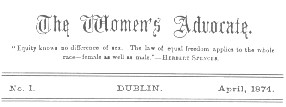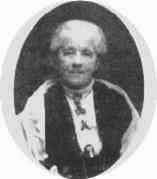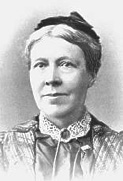The campaign begins
Groups calling for reform of all kinds of laws affecting women, were set up in towns and cities during the middle of the nineteenth century. Many women who joined were also involved in philanthropic (charitable) work and in campaigns opposing slavery and demanding better education for women. Essentially they were arguing for greater equality. In England they met mostly in Manchester and cotton towns in the north at first.
In Belfast, Isabella Tod was active in several campaigns. She was greatly in demand as a lecturer and wrote many articles and pamphlets. She was consulted by the British government about reform of the Married Women's Property Acts and founded the first Women's Franchise organisation in Ireland, the Northern Ireland Society for Women's Suffrage in 1872.
Anne Robertson of Blackrock was lobbying politicians and organising lectures in Dublin as early as 1866. Perhaps better known was Anna Haslam who founded the Dublin Women's Suffrage Association in 1876. She was a committed woman like Isabella Tod and had been active in campaigns for temperance, peace, women's education and anti-slavery.
An excellent organiser, she and her husband, Thomas Haslam, belonged to the Society of Friends or 'Quakers'. She was secretary of the Dublin Women's Suffrage Association - later renamed the Irish Women's Suffrage and Local Government Association (IWSLGA) - from 1876 until 1913 when she retired and became Life President.
|
Anna and Thomas Haslam and their group aimed to educate public opinion in Ireland about women's issues. Thomas edited the paper Women's Advocate and the group wrote pamphlets and letters to newspapers. They held public and drawing-room meetings to which they invited speakers on women's issues, including leading figures from the UK and the USA. They lobbied politicians and sent petitions and deputations to Parliament.
|

Masthead of The Women's Advocate, April 1874 |
This first wave of the Irish suffrage movement was spearheaded by middle class Quakers and Protestants of property and education. Progress was slow but in 1898 there were branches in Tralee, Sligo, Skibbereen, Strokestown and Miltown Malbay. Membership rose to 647 in 1911 and then tapered off for reasons that will emerge later.
|
The Haslams were among twenty five Irish people who signed a petition to the British parliament in 1866 asking that all householders, including women, be given the vote. The petition was signed by 1,500 people in all and was presented in the House of Commons by John Stuart Mill, MP, a distinguished philosopher and economist, co-author of The subjection of women.
Next, Mill proposed an amendment to the Second Reform Bill (1867) by which the words 'male person' would be replaced by 'person' but this was rejected by 194 votes to 73.
|

Anna Haslam |

Isabella Tod |
|
From Ireland we hear that a petition already signed by two thousand persons is still receiving signatures at Dublin, while smaller petitions are being sent to some other neighbouring towns. We are glad to hear that at Tramore both the Protestant rector and the Catholic priest have signed the petition. This is as it ought to be.
Englishwoman's Review. April 1868. |
In 1870 the first of many Women's Suffrage Bills presented in the House of Commons failed to progress past a second reading. Amongst other interventions which failed was a petition for women's suffrage from the citizens of Dublin presented by Charles Stewart Parnell to the House of Commons in 1887.
Under whatever conditions, and within whatever limits, men are admitted to the suffrage, there is not a shadow of justification for not admitting women under the same. The majority of the women of any class are not likely to differ in political opinion from the majority of the men of the same class, unless the question be one in which the interests of women, as such, are in some way involved; and if they are so, women require the suffrage, as their guarantee of just and equal consideration.
John Stuart Mill,The Subjection of women, 1869. |
The photograph of Isabella Tod is reproduced with the kind permission of the Museums and Galleries of Northern Ireland


